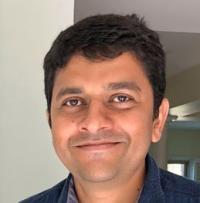
BG 10 RM 5C440
10 CENTER DR
BETHESDA MD 20814
Dr. Bhagavatheeshwaran earned his Bachelor of Technology in Biomedical Engineering from Cochin University of Science and Technology in India and his Master of Science in Biomedical Engineering from Drexel University in Philadelphia. He earned his Ph.D. in Biomedical Engineering and Medical Physics from Worcester Polytechnic Institute and University of Massachusetts where he studied and developed Magnetic Resonance Imaging techniques for imaging the retina with Drs. Timothy Q. Duong, Michalle Pardue, and Michael Kuhar.
During his postdoctoral fellowship with Drs. Xiaoping Hu and Michael Benatar at Emory University, he worked on developing specialized magnetic resonance imaging techniques and markers of disease progression in patients affected by amyotrophic lateral sclerosis (ALS). He joined the National Institutes of Health in 2011 as a Staff Scientist. He has received the Dean’s Fellowship at Drexel University.
He has received awards including best poster and educational or student stipends for his work from the International Society of Magnetic Resonance in Medicine and Gordon Research Conferences. In 2015, he received the Special Act or Service Award from the Office of Human Resources at the NINDS, NIH. Currently he is working on developing imaging markers of neuroinflammatory diseases such as multiple sclerosis, Human T-cell leukemia virus, type 1 or HTLV-1 associated myelopathy/tropical spastic paraparesis (HAM/TSP), Progressive multifocal leukoencephalopathy (PML), and neurocognitive impairments in HIV infection at the Neuroimmunology clinic at the NINDS.
As an MRI physicist, Dr. Bhagavatheeshwaran‘s research focuses on techniques to improve the sensitivity and specificity of MRI in detecting changes in the neuronal microenvironment in neuroinflammatory diseases, which could help with understanding disease processes in-vivo. At present, his research focuses on developing quantitative MRI markers of disease progression in neuroinflammatory diseases such as multiple sclerosis, Human T-cell leukemia virus, type 1 or HTLV-1 associated myelopathy/tropical spastic paraparesis (HAM/TSP), Progressive multifocal leukoencephalopathy (PML), and neurocognitive impairments in HIV infection.
Current members:
Henry Dieckhaus
Kendyl Bree
William Mullins (Andrew)
Former members:
Jawad Aqeel
Click here for a full list of publications
Selected Publications:
1. Lee MH, Perl DP, Nair G, Li W, Maric D, Murray H, Dodd SJ, Koretsky AP, Watts JA, Cheung V, Masliah E, Horkayne-Szakaly I, Jones R, Stram MN, Moncur J, Hefti M, Folkerth RD, Nath A. Microvascular Injury in the Brains of Patients with COVID-19. N Engl J Med. 2021 Feb 4;384(5):481-483. doi: 10.1056/NEJMc2033369. Epub 2020 Dec 30. PMID: 33378608
2. Nair G, Dodd S, Ha SK, Koretsky AP, Reich DS. Ex vivo MR microscopy of a human brain with multiple sclerosis: Visualizing individual cells in tissue using intrinsic iron. Neuroimage. 2020 Dec;223:117285. doi: 10.1016/j.neuroimage.2020.117285. Epub 2020 Aug 20. PubMed PMID: 32828923
3. Beck ES, Gai N, Filippini S, Nair G, Reich DS; Inversion Recovery Susceptibility Weighted Imaging with Enhanced T2-Weighting (IR-SWIET) at 3 Tesla Improves Visualization of Subpial Cortical Multiple Sclerosis Lesions. Invest Radiol. 2020;10.1097 PMID: 32604385 PMCID: PMC7541598
4. Azodi S, Nair G, Enose-Akahata Y, Charlip E, Vellucci A, Cortese ICM, Dwyer J, Billioux JB, Thomas C, Ohayon J, Reich DS, Jacobson S; Imaging Spinal Cord Atrophy in Progressive Myelopathies; Annals of Neurology 82(5):719-728; 2017 Nov; DOI: 10.1002/ana.25072
5. Absinta M, Ha SK, Nair G, Sati P, Luciano NJ, Palisoc M, Louveau A, Zaghloul KA, Pittaluga S, Kipnis J, Reich DS. Human and nonhuman primate meninges harbor lymphatic vessels that can be visualized noninvasively by MRI. Elife. 2017 Oct 3;6. pii: e29738
6. Nair G*, Absinta M*, Filippi M, Ray-Chaudhury A, Reyes-Mantilla MI, Pardo CA, Reich DS; Postmortem MRI to guide the pathological cut: Individualized, 3D-printed cutting boxes for fixed brains; J Neuropathology and Exp Neurology, 2014 Aug; 73(8):780-788.
7. Selvaganesan K, Whitehead E, DeAlwis PM, Schindler MK, Inati S, Saad ZS, Ohayon JE, Cortese ICM, Smith B, Steven Jacobson, Nath A, Reich DS, Inati S, Nair G. Robust, atlas-free, automatic segmentation of brain MRI in health and disease. Heliyon. 2019 Feb;5(2):e01226. doi: 10.1016/j.heliyon.2019.e01226. PMID: 30828660; PMCID: PMC6383003
